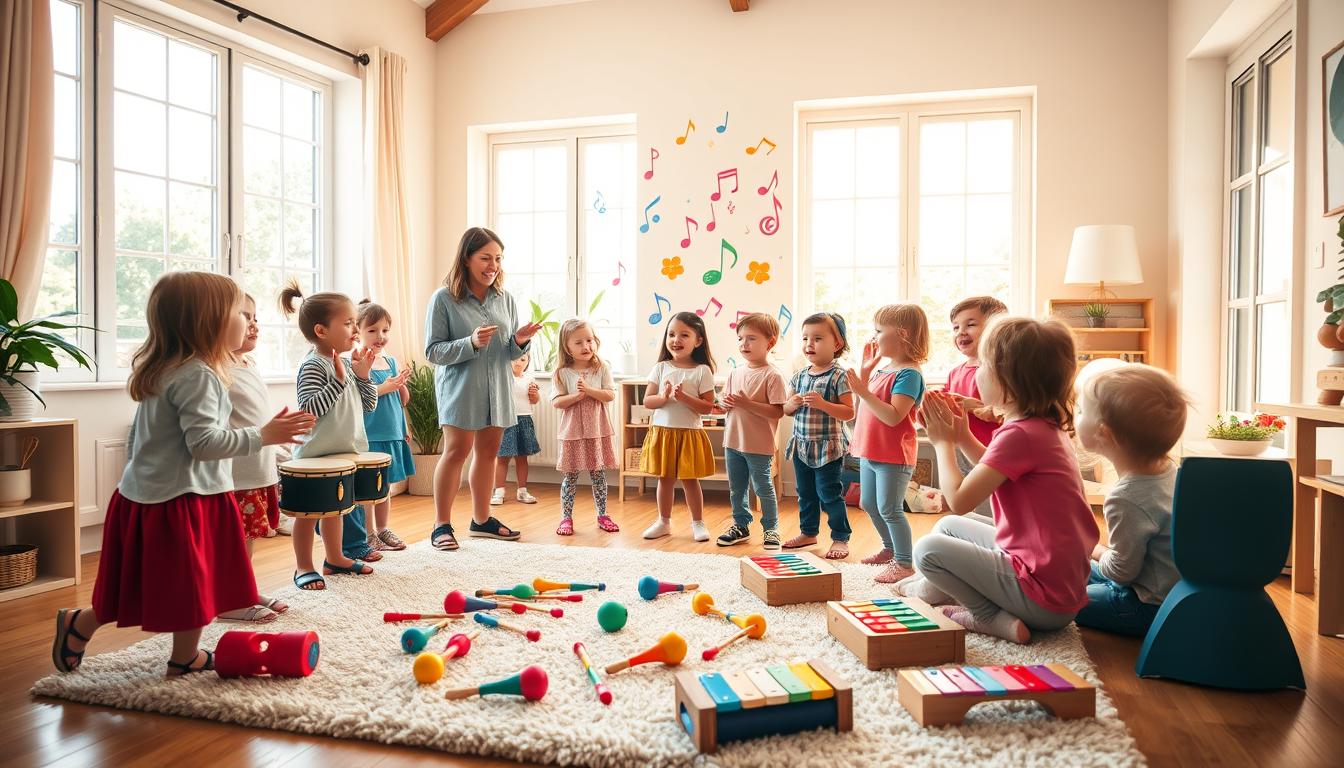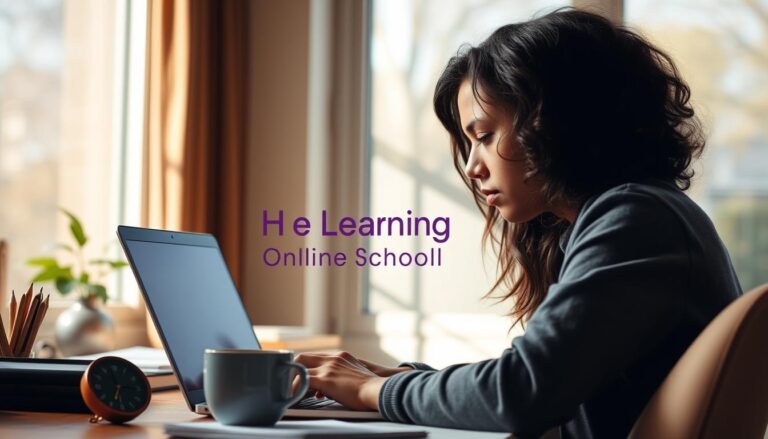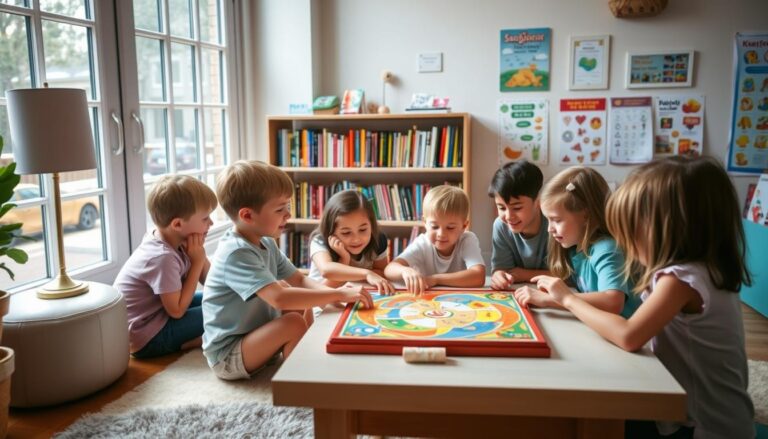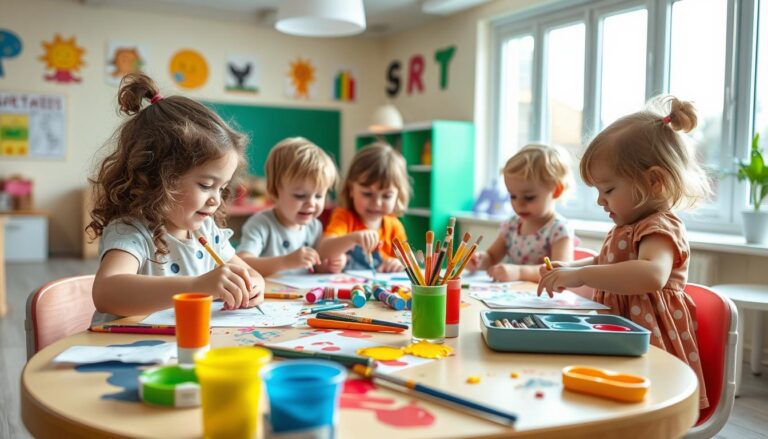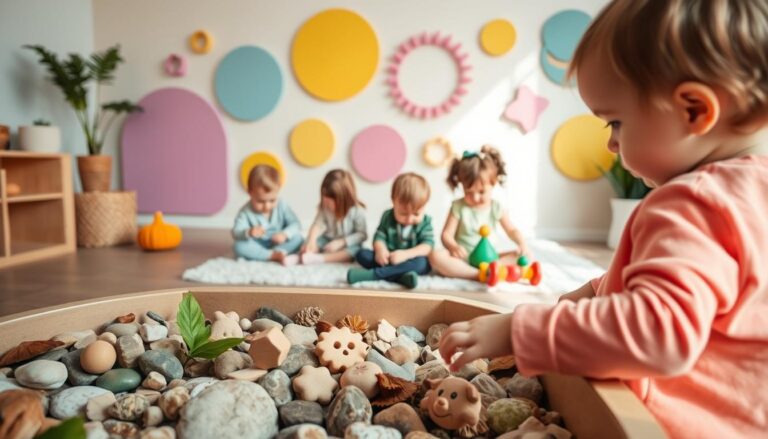Music and Movement in Home Pre-School
Have you ever wondered how simple songs and movement can transform your child’s learning experience? Combining these elements isn’t just fun—it’s a powerful way to nurture creativity and development in young minds.
We believe that every child thrives when learning is engaging and interactive. By introducing musical instruments and songbooks, you can create a vibrant environment that sparks curiosity and joy. These activities help children build essential skills like coordination, rhythm, and body awareness.
In this article, we’ll explore creative ideas to bring music and movement into your home. From action songs to rhythm games, these activities are designed to make learning both effective and enjoyable. Stay tuned as we dive into practical tips and resources to inspire your child’s growth.
Introduction to Music and Movement in Home Pre-School
What if combining rhythm and motion could unlock your child’s potential? In home-based learning, blending sound and movement creates a dynamic environment for growth. This approach helps young learners develop essential skills while having fun.
Engaging with songs and dance fosters imagination and coordination. Children naturally respond to rhythm, making it a powerful tool for learning. Structured routines, paired with creative freedom, encourage exploration and self-expression.
Modern tools like apps and streaming lessons make it easier to integrate these activities into daily routines. For example, rhythm games and interactive lessons can enhance attention spans and motor skills. These resources provide a balanced mix of education and enjoyment.
Here’s a comparison of traditional and modern approaches to music and movement:
| Approach | Traditional | Modern |
|---|---|---|
| Tools | Basic instruments, songbooks | Apps, streaming lessons |
| Focus | Repetition and memorization | Interactive and adaptive learning |
| Benefits | Develops rhythm and coordination | Enhances cognitive and motor skills |
By blending these methods, we create a rich learning experience. Children thrive when they can explore sound and motion in a supportive environment. Let’s dive deeper into how these activities can shape your child’s early years.
The Role of Music in Early Childhood Development
Did you know that rhythm and melody can shape a child’s early years? Research shows that engaging with sound and motion fosters cognitive, social, and physical growth. These elements create a foundation for essential skills that last a lifetime.
Benefits for Cognitive and Social Growth
Music plays a vital role in brain development. Studies reveal that exposure to rhythm and beats enhances language skills and concentration. For example, action songs introduce new words, helping children expand their vocabulary.
Socially, music strengthens bonds. Singing together or dancing in groups encourages teamwork and emotional expression. These interactions build confidence and empathy, key traits for healthy relationships.
Enhancing Motor Skills Through Movement
Movement is equally important. Dancing to a beat or clapping along to a song improves coordination and body awareness. Structured activities like rhythm games develop both fine and gross motor skills.
For instance, tapping objects to reproduce rhythms strengthens hand muscles. Meanwhile, dancing builds muscle strength in arms, legs, and the trunk. These activities make learning both fun and effective.
| Aspect | Cognitive Benefits | Motor Skill Benefits |
|---|---|---|
| Music | Improves language and memory | Enhances hand-eye coordination |
| Movement | Boosts attention and focus | Strengthens balance and agility |
By combining music and movement, we create a holistic learning experience. These activities not only nurture development but also bring joy and creativity into a child’s daily routine.
Understanding Preschool Music Activities
What makes rhythm and sound so powerful in early learning? Preschool music activities are designed to engage young minds through playful, interactive experiences. Unlike traditional lessons, these exercises focus on exploration rather than formal instruction.
These activities help children develop essential skills like listening, coordination, and creativity. For example, using rhythm sticks or clapping to a beat enhances motor skills. Singing simple songs introduces new words and improves language development.
Here’s how preschool music activities differ from conventional methods:
- They prioritize fun and engagement over structured learning.
- Children explore sounds and beats through hands-on experiences.
- Activities often involve everyday objects, like turning a box into a drum.
For instance, creating a musical instrument from household items teaches resourcefulness. A child can use a stick and a tin can to make a drum. This not only introduces them to sound but also encourages problem-solving.
Simple exercises, like clapping or tapping to a rhythm, build body awareness. These activities are easy to incorporate into daily routines, making learning seamless and enjoyable. By blending play with education, we create a foundation for lifelong curiosity and growth.
Creative Movement Games for Preschoolers
How can movement and rhythm make learning more exciting for your child? Creative movement games are a fantastic way to blend physical activity with fun. These games not only keep children engaged but also help them develop essential skills like coordination and teamwork.
Action Songs and Freeze Dance
Action songs are a great way to get children moving while learning. For example, singing “The Hokey Pokey” encourages body awareness and coordination. Freeze dance is another favorite. Play a song and have the child dance until the music stops. This game improves listening skills and self-control.
Circle Time Movement Games
Circle time activities are perfect for group settings. Games like “Follow the Leader” encourage imitation and leadership. Children take turns leading movements, fostering social skills and creativity. These activities can be adapted for different spaces and group sizes, making them versatile for home or classroom use.
These games are more than just fun. They help children develop motor skills, build confidence, and manage emotions. For more ideas on fostering holistic development, explore our preschool program.
DIY Musical Instruments and Props for Home Classrooms
Ever thought about turning everyday items into musical wonders? DIY instruments are a fantastic way to spark creativity and learning at home. Using simple objects, you can create tools that inspire rhythm, sound, and movement.
These homemade props not only save money but also encourage hands-on experimentation. Children learn to explore different sounds while developing motor skills and coordination. Let’s dive into some fun and easy projects you can try today.
Crafting Homemade Drums and Shakers
Drums and shakers are simple to make and perfect for introducing rhythm. For a drum, use an empty coffee can or oatmeal container. Cover the open end with a balloon or plastic wrap, securing it with a rubber band. This creates a drumhead that produces a satisfying beat.
Shakers can be made from plastic eggs or small bottles. Fill them with rice, beans, or beads, then seal them tightly. Decorate the outside with colorful tape or stickers to make them visually appealing. These instruments are great for teaching patterns and coordination.
Designing Colorful Music Cubes and Bells
Music cubes are a creative way to combine movement and sound. Use small cardboard boxes and attach bells or jingle bells to the edges. Decorate the cubes with bright colors and patterns. Children can roll or shake them to create rhythmic sounds.
Bells can also be attached to wristbands or anklets. Use elastic bands and sew or glue bells onto them. These props are perfect for dancing and exploring rhythm through movement.
td>Develops rhythm and coordination
| Instrument | Materials | Benefits |
|---|---|---|
| Drum | Coffee can, balloon, rubber band | |
| Shaker | Plastic egg, rice, tape | Encourages pattern recognition |
| Music Cube | Cardboard box, bells, decorations | Combines movement and sound |
| Bell Wristband | Elastic band, bells | Enhances rhythm through dance |
DIY instruments are more than just fun. They help children build confidence, creativity, and a love for sound. For more ideas on using creative props, check out this resource.
Remember to choose safe, non-toxic materials and supervise children during play. These projects are a wonderful way to blend learning and creativity in your home classroom.
Integrating Song and Dance into Daily Routines
Looking for ways to make learning fun and engaging for your child? Incorporating song and dance into daily routines can transform ordinary moments into opportunities for growth. These activities not only entertain but also enhance cognitive and motor skills.
Short bursts of song and dance can reenergize any setting. For example, a quick dance break during study time can improve focus and mood. Apps like Prodigies offer interactive lessons that make it easy to weave these activities into your schedule.
Parental involvement plays a key role in fostering a love for rhythm and movement. Singing along with your child or joining in a dance game strengthens bonds and encourages participation. Consistency is essential to build lasting musical habits.
Here’s a comparison of structured and spontaneous musical activities:
| Activity Type | Structured | Spontaneous |
|---|---|---|
| Example | Daily singing time | Dance breaks during play |
| Focus | Skill development | Creativity and fun |
| Benefits | Builds discipline | Encourages free expression |
Balancing structured lessons with spontaneous dance breaks keeps learning dynamic. For instance, using a song to signal cleanup time can make transitions smoother. These strategies create a vibrant environment where children thrive.
Music apps and streaming lessons are excellent tools for guiding routines. They provide a mix of education and entertainment, making it easier to integrate rhythm into daily life. With consistency and creativity, you can make song and dance a natural part of your child’s day.
Blending Art with Music for Creative Expression
Have you considered how blending art with sound can unlock a child’s creativity? Combining visual art with rhythm and melody creates a multi-sensory experience that enhances learning and self-expression. This approach encourages children to explore their imagination while developing essential skills.
Art projects can complement musical activities by allowing children to express what they hear. For example, painting while listening to classical tunes helps them connect emotions with sound. This process fosters creativity and a deeper understanding of rhythm and beat.
Painting Along with Classical Tunes
Classical music provides a rich backdrop for artistic exploration. Pieces by composers like Beethoven or Tchaikovsky evoke different emotions and tempos. Encourage children to paint freely while listening, letting the music guide their brushstrokes. This activity enhances their ability to interpret sound visually.
For instance, fast-paced melodies might inspire bold, energetic strokes, while slower tunes could lead to softer, flowing patterns. This exercise not only builds creativity but also improves focus and listening skills.
Drawing Rhythms and Beats
Drawing can also be a powerful way to interpret rhythm. Ask children to draw what they hear, using lines, shapes, and colors to represent beats and melodies. This activity helps them visualize sound and understand musical concepts in a tangible way.
- Use simple rhythms to start, like clapping or tapping patterns.
- Encourage free-form drawing to let their imagination flow.
- Discuss their creations to reinforce the connection between sound and art.
Combining art with music engages both the mind and body, creating a holistic learning experience. These activities are adaptable for home or classroom settings, making them a versatile tool for fostering creativity and growth.
Leveraging Technology in Music Learning
Have you explored how technology can transform your child’s musical journey? Modern tools like apps and streaming lessons bring a new dimension to learning rhythm and sound. These resources make education interactive, engaging, and accessible for every child.
Digital platforms offer features like pitch recognition games and color-coded sheet music. These tools help children understand complex concepts in a fun way. For example, apps like Prodigies use visual cues to teach rhythm and melody, making learning intuitive and enjoyable.
Utilizing Music Apps and Streaming Lessons
Music apps provide interactive lessons that adapt to your child’s pace. Streaming platforms offer a variety of lessons, from basic rhythms to advanced melodies. These tools create opportunities for group participation, even in a home setting.
Here’s a comparison of traditional and tech-enhanced learning methods:
| Feature | Traditional | Tech-Enhanced |
|---|---|---|
| Learning Tools | Basic instruments, songbooks | Apps, streaming lessons |
| Interaction | Limited to in-person guidance | Interactive games, adaptive lessons |
| Group Participation | In-person only | Virtual group activities |
Integrating technology into music education creates a dynamic learning environment. It bridges the gap between traditional methods and modern needs, making education more effective and enjoyable. With these tools, your child can explore rhythm and sound in a way that’s both fun and educational.
Group Music and Movement Activities for Social Learning
How can group activities foster both musical skills and social connections? Collaborative exercises are a fantastic way to teach rhythm while nurturing teamwork. These activities help children develop coordination, body awareness, and social bonds.
Circle games are particularly effective for building connections. For example, passing a bell or tambourine around a circle encourages listening and patience. Each child waits for their turn, fostering respect and cooperation.
Games like “Follow the Leader” or “Musical Statues” teach body control and timing. Children mimic movements or freeze when the music stops, enhancing their ability to follow directions. These exercises also improve motor skills and focus.
Collaborative Circle Games
Circle games are designed to engage every child in the group. Activities like “Open, Shut Them” involve repetitive hand movements, teaching fine motor skills. Singing together strengthens language development and phonetic awareness.
Using simple instruments, such as shakers or drums, adds rhythm to the experience. Children can create beats together, learning to synchronize their movements. This builds a sense of unity and shared achievement.
| Activity | Skills Developed |
|---|---|
| Pass the Bell | Listening, patience, teamwork |
| Follow the Leader | Body control, coordination |
| Musical Statues | Focus, timing, direction |
| Open, Shut Them | Fine motor skills, rhythm |
Group activities also enhance social-emotional development. Singing in unison or dancing together creates a sense of belonging. These experiences build confidence and empathy, essential traits for healthy relationships.
For more ideas on safe and engaging group activities, explore this resource. By incorporating these exercises, we create a dynamic environment where children thrive both musically and socially.
Practical Tips for Parents to Encourage Musical Exploration
Want to spark your child’s creativity with simple, everyday ideas? Parents play a key role in nurturing a love for rhythm and sound. By integrating musical exploration into daily routines, you can create a fun and engaging learning environment.
Start by using household items to create instruments. For example, a pot and spoon can become a drum, while a rice-filled bottle makes a great shaker. These DIY tools encourage hands-on learning and creativity.
Here are some practical strategies to try:
- Set aside short, daily lessons to explore rhythm and sound.
- Turn chores into musical moments, like singing while cleaning.
- Use positive reinforcement to celebrate small achievements.
Group activities can also enhance social skills. Gather siblings or friends for a rhythm game. For instance, pass a tambourine around a circle, encouraging teamwork and patience.
Encourage your child to tap their foot or clap along to a beat. These simple actions build coordination and body awareness. Short, engaging lessons can fit into even the busiest schedules.
Remember, every kid enjoys making their own instruments. Use simple words to explain rhythm and let them explore freely. By creating a safe and stimulating environment, you’ll inspire a lifelong love for sound and movement.
Adapting Activities for Different Age Groups
Ever wondered how to tailor musical experiences to suit your child’s age? Every child develops at their own pace, and activities should reflect their unique needs. By adjusting rhythm and movement games, we can create engaging and effective learning moments for both younger and older children.
Younger children, like 3-year-olds, have shorter attention spans and are still mastering basic motor skills. Older preschoolers, such as 5-year-olds, are more coordinated and can handle complex tasks. Let’s explore strategies to adapt activities for these two age groups.
Strategies for 3-Year-Olds
For 3-year-olds, simplicity is key. Focus on activities that build basic coordination and body awareness. For example, clapping to a beat or tapping their foot helps develop rhythm. Use short, repetitive songs to keep their attention.
Hand-eye coordination can be improved with simple instruments like shakers or drums. Encourage your child to explore sounds freely. This fosters creativity while building fine motor skills.
Engaging 5-Year-Olds Effectively
Five-year-olds are ready for more challenging activities. Introduce games that require following directions, like freeze dance or rhythm patterns. These activities enhance listening skills and body control.
Older children can also handle group activities. For instance, passing a tambourine in a circle teaches teamwork and patience. These exercises balance fun with skill development.
| Activity | 3-Year-Olds | 5-Year-Olds |
|---|---|---|
| Clapping to a Beat | Simple, repetitive patterns | Complex rhythms with variations |
| Freeze Dance | Short bursts of movement | Longer sequences with pauses |
| Group Games | Basic turn-taking | Teamwork and coordination |
By tailoring activities to your child’s age, we ensure they remain engaged and challenged. These adaptations not only support development but also make learning enjoyable. Encourage your child to explore rhythm and movement in a way that suits their stage of growth.
Overcoming Challenges in Home Preschool Music Sessions
Struggling to keep your child engaged during music sessions at home? Many parents and educators face common hurdles like short attention spans and balancing structure with creativity. Addressing these challenges effectively can transform your sessions into enjoyable and productive learning opportunities.
One of the biggest obstacles is managing short attention spans. Young children often lose focus quickly, especially during structured activities. To combat this, vary the pace and type of activities. For example, alternate between a lively dance game and a calming song to maintain interest.
Managing Short Attention Spans
Here are some strategies to keep your child engaged:
- Use quick transitions between activities to maintain momentum.
- Incorporate props like rhythm sticks or shakers to add a tactile element.
- Keep sessions short and focused, gradually increasing the time as their attention span improves.
For instance, if your child starts to lose interest, switch to a quick freeze dance game. This not only re-engages them but also helps develop listening skills and body control.
Balancing Structure with Creative Freedom
While structure is important, too much rigidity can stifle creativity. Striking the right balance ensures your child enjoys the process while still learning essential skills. Start with a clear plan but leave room for spontaneous exploration.
For example, begin with a structured song like “The Wheels on the Bus,” then allow your child to create their own verses. This encourages creativity while reinforcing rhythm and language skills.
| Challenge | Solution |
|---|---|
| Short Attention Spans | Use varied and dynamic activities |
| Lack of Engagement | Incorporate props and quick transitions |
| Overly Structured Sessions | Balance structure with creative freedom |
Maintaining a positive atmosphere is key. If disruptions occur, reset with a fun, interactive game like “Simon Says” or a quick clapping rhythm. This helps re-engage your child and keeps the session enjoyable.
By addressing these challenges, you can create a vibrant and effective learning environment. With the right strategies, every music session becomes an opportunity for growth and joy.
Conclusion
Bringing rhythm and motion into your child’s daily routine can spark creativity and growth. By blending sound and movement, we create a dynamic environment that supports cognitive, social, and emotional development. Simple strategies, like DIY instruments or action songs, make learning both fun and effective.
These activities not only enhance motor skills but also foster self-expression and teamwork. For example, group games like “Follow the Leader” or “Musical Statues” teach coordination while building social bonds. Consistency in these practices helps children develop a lasting love for exploration and learning.
We encourage parents and educators to try these ideas at home. For more resources on how to enhance children’s learning, visit our middle school program. Let’s inspire the next generation through the joy of rhythm and motion.

